After mounting a title challenge in the 2019/20 season and reaching UEFA Champions League football for the first time in five years, Lazio struggled for large parts of the previous campaign.
Head coach Simone Inzaghi believed that he had taken the Biancocelesti as far as he possibly could and so when Antonio Conte resigned from his position at Internazionale, Inzaghi was appointed as his successor.
Merely days later, it was reported in the Italian press that Lazio knew who they wanted as Inzaghi’s replacement and on June 9, the former Chelsea and Juventus manager Maurizio Sarri took charge of the Italian club.
Sarri is quite a divisive character it seems and many of his former players have spoken out against the 62-year-old.
It was even believed that the manager fell out with Cristiano Ronaldo during his time in Turin, leading to doubts about the coach’s man-management ability.
However, what cannot be doubted is his aptitude to get the best out of the squad at his disposal and play a very attractive brand of football in the process.
Lazio will be one of the most entertaining teams this season and kick off their Serie A campaign against Empoli on Saturday.
This article will be a tactical analysis of how Lazio will look to play under Maurizo Sarri tactics
It will be an analysis of the tactics that the experienced manager will look to deploy in the Italian capital.
Maurizo Sarr Formation & Lineups
Last season, Inzaghi utilised the 3-5-2 in 79 percent of Lazio’s games.
This was the manager’s favoured formation throughout his entire five-year tenure at the Stadio Olimpico.
Interestingly, Sarri almost always deploys a 4-1-4-1 or a 4-3-3 so Lazio have seen a slight shift in the formation used as well as the overall set-up.
At Juventus, the Italian’s preferred structure was the 4-3-1-2, although he did use a 4-3-3 and a 4-4-2 as well.
The reason the 4-3-1-2 was deployed by the coach in Turin was because of the personnel in the Juventus squad.
The Bianconeri had a lot of very good midfield players but not enough wide players and so Sarri believed that a slight structural change to a two-striker system was best.
There was talk that maybe the ex-Napoli manager would look to stay with this formation but in all of Lazio’s pre-season games so far, he has deployed the 4-3-3/4-1-4-1 so this looks like Lazio’s set-up going forward.
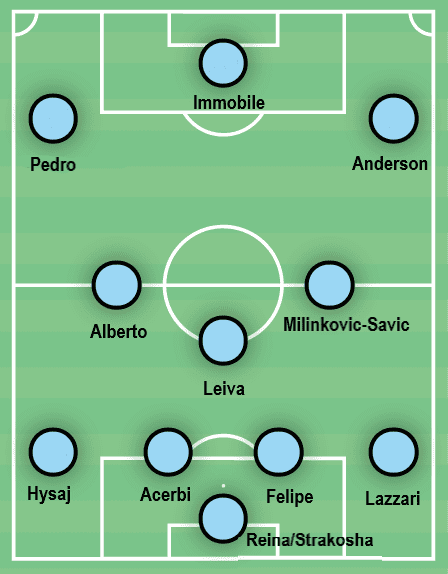
This will likely be Lazio’s starting lineup against Empoli at the weekend.
The goalkeeping position is still an area of contention within the team.
Pepe Reina, formerly under Sarri at Napoli, and Thomas Strakosha are both battling for the number one spot and so the Italian manager will need to make a decision as to who his first-choice keeper will be.
There is a high chance that the back four will consist of Elseid Hysaj, Francesco Acerbi, Luiz Felipe, and Manuel Lazzari, while the midfield trio could comprise Lucas Leiva as the lone ‘6’ with Luis Alberto and Sergej Milinkovic-Savic as the two ‘8s’.
Ciro Immobile will certainly start as the lone striker and should be flanked by Felipe Anderson on the right-wing.
New, and controversial, signing Pedro will start on the left for Lazio too following his contentious move to Roma’s biggest rivals this past week.
Sarri has worked with Pedro before at Chelsea and so this signing makes quite a lot of sense.
Perhaps Pedro may be utilised on the right with Anderson on the left but this should not make too much difference to Lazio’s overall game.
Positional play performance
One area of Lazio’s game which will see a massive upheaval in performance under the new manager is in terms of their average possession per 90 and passes in the final third.
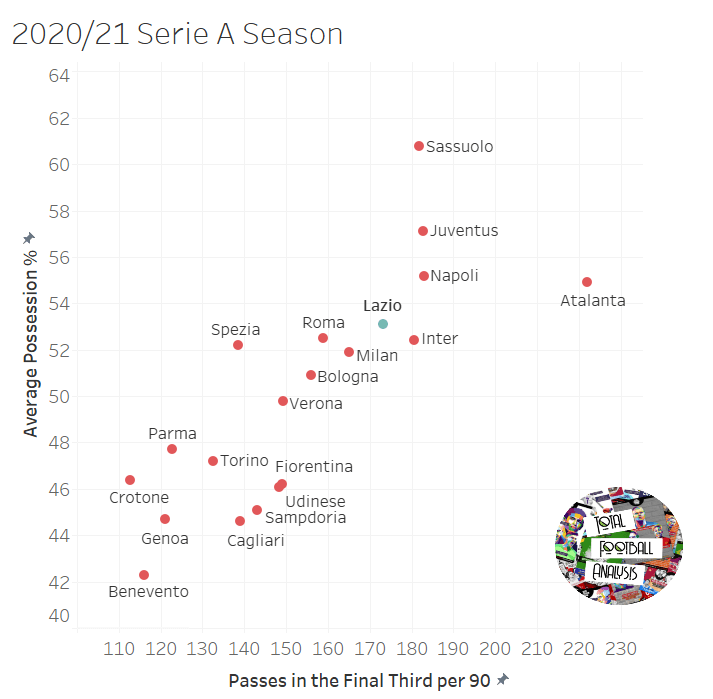
The graph above shows how Lazio performed on these metrics last season.
Inzaghi’s side actually did quite well and beat top sides such as Milan and Roma in terms of passes in the final third per 90, which stood at 173.1, and their average ball possession per game of 53.1 percent.
In the previous campaign, Lazio accumulated the fifth-highest average ball possession over the course of the season and the sixth-highest number of passes in the final third per 90.
These are very respectable rankings and are accredited to Inzaghi’s style of play.
Nonetheless, next season, it is expected that Lazio will be performing much better on this graph given the nature of how Sarri wants his team to play.
Looking at the Italian manager’s previous two seasons in Serie A with Juventus and Napoli, his sides were always one of the top-performing sides in the country on these metrics.
In fact, his Napoli team in 2017/18 were the highest-performing side, in terms of these metrics, across both seasons.
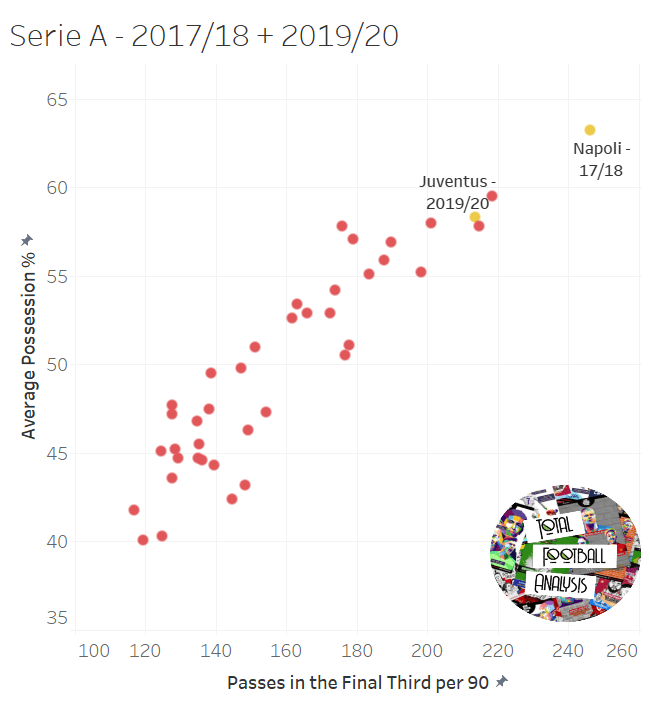
Build-up phase
Sarri will look to apply his positional play principles to Lazio’s game when they are in possession of the ball.
Deploying the 4-3-3, when his teams are in the build-up phase, Sarri wants his three midfield players to stagger and position themselves in different areas of the pitch in order to stretch the opposition vertically.
This creates gaps in the opponent’s high-press that can be exploited through neat, tidy, and precise passing.
In the meantime, the fullbacks and wingers keep the width in the wide areas, stretching horizontally.
Again, this ensures that Sarri’s side has a lot of space to play into.
In the build-up phase of the attack, the 62-year-old wants his fullbacks to push higher too, allowing the two centre-backs to move wide and create a three-man line with the goalkeeper.
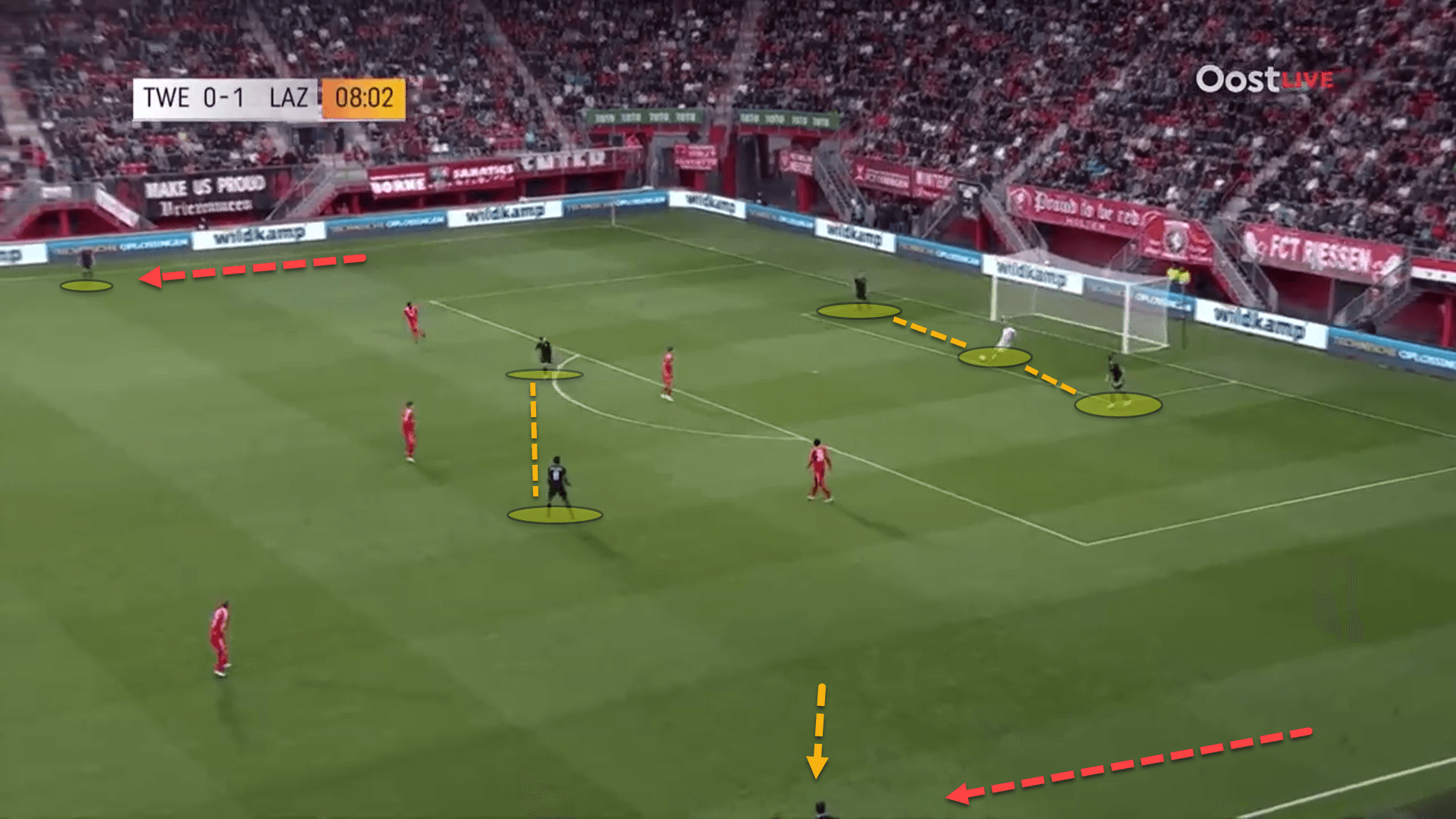
This set-up in the first phase was evident from a recent pre-season friendly that Lazio played against FC Twente.
Although Milinkovic-Savic cannot be seen until the next image, Lazio’s three central midfielders are all staggered, which is creating depth and stretching Twente vertically, leaving space to play into.
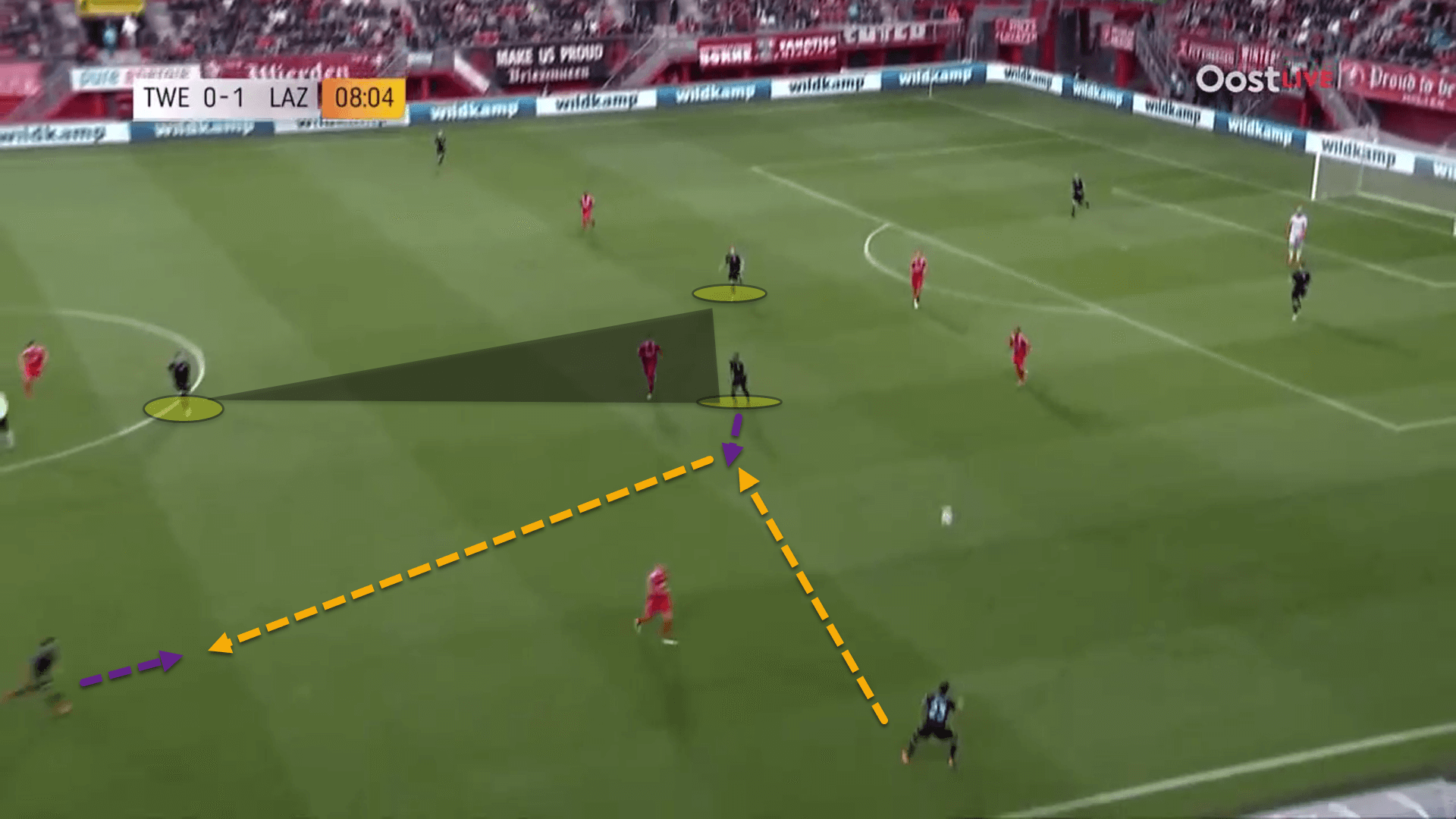
Due to how stretched the opposition’s high-press is because of the staggered positioning of the central midfielders, Lazio find it quite easy to progress their way from the first third of the pitch into the middle third with quick passing.
Sarri’s sides also like to break through an opponent’s high block by baiting the press before playing through it.
Napoli, under his management, did this particularly well using Jorginho due to his ability to play line-breaking passes through the first line of the opposition’s pressure.
The baiting of the press is usually triggered by a backward pass which draws the opposition to press the pass higher up the pitch.
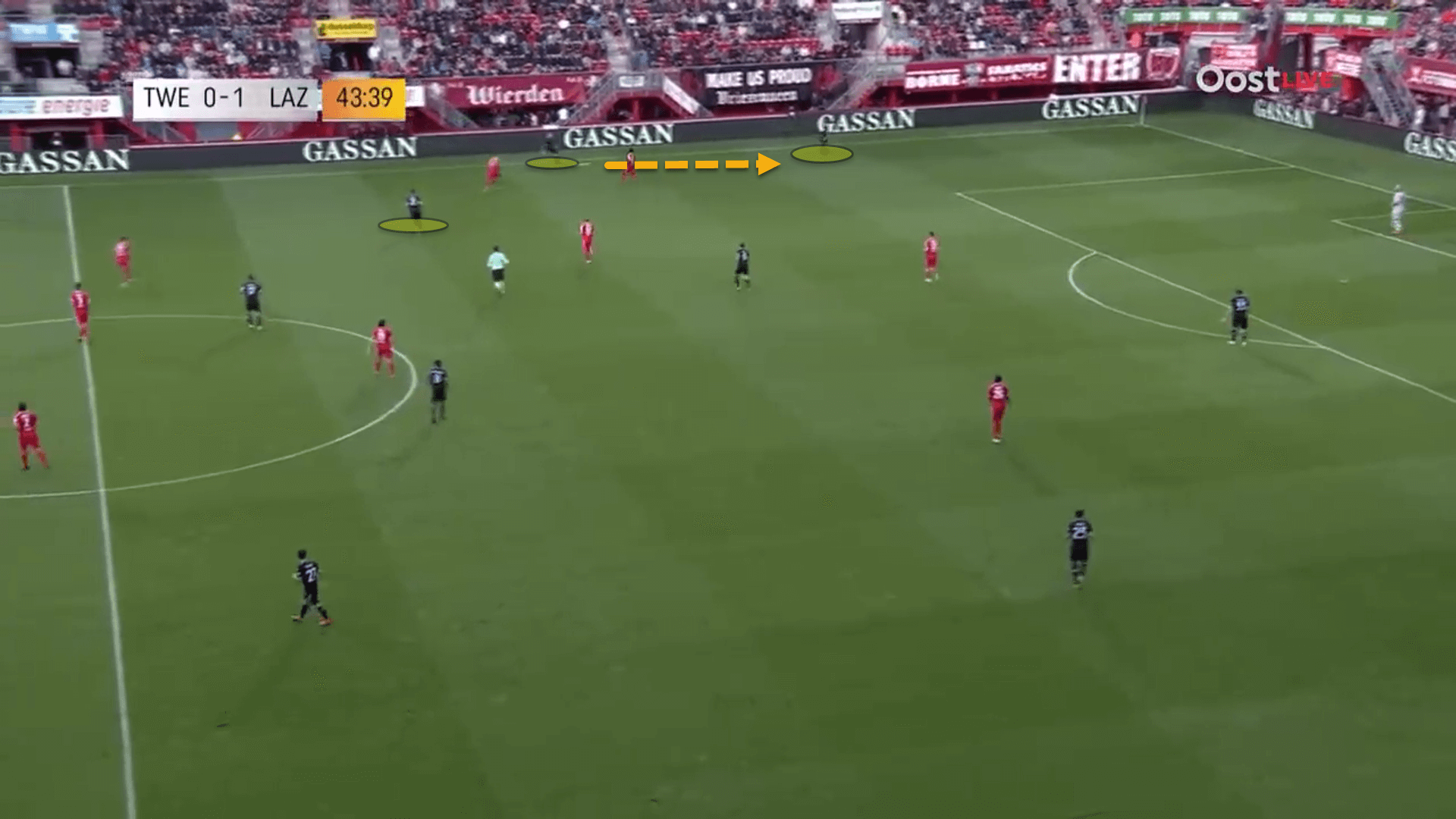
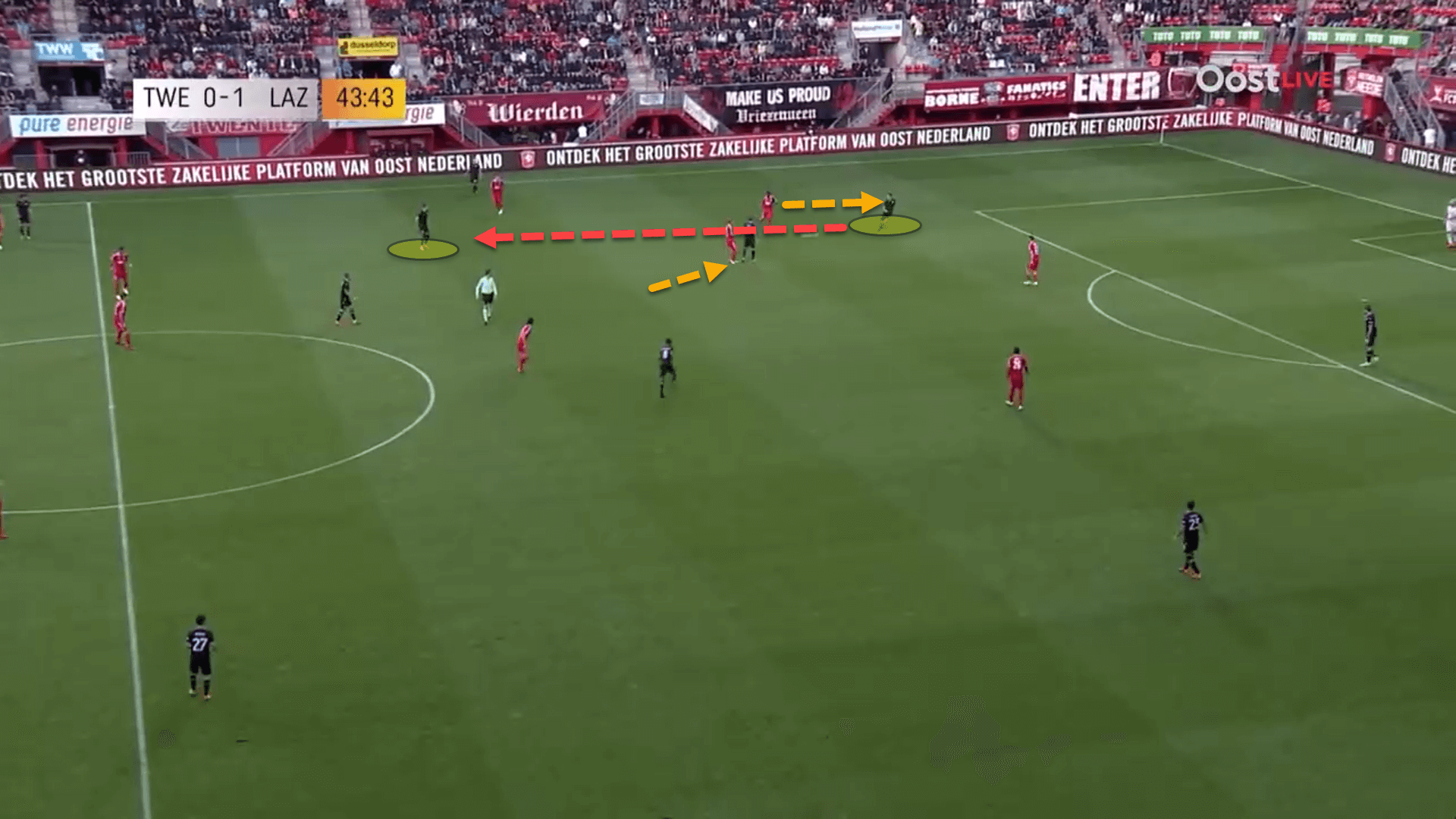
In the examples provided, Lazio’s right-back has played a backward pass into the ball-near centre-back.
This has caused the Twente players to press higher as backward passing is usually a trigger for this.
Milinkovic-Savic sees the space left by one of Twente’s central midfielders who have been baited out by the backward pass.
He moves into this space and the Lazio defender is able to slide a ball into his feet, breaking the opposition’s first line of pressure and beating the high-press, leaving Lazio in an advanced position on the pitch having taken out a number of players with one pass.
Progression Phase
When the Biancocelesti have possession of the ball in the middle third in a positional attack, also known as the progression phase, their structure becomes a lot narrower in the central areas.
Sarri is a major advocate for having positional superiority between the lines.
Positional superiority essentially means that the coach wants to have quality players positioned between the opposition’s midfield and backline who can receive the ball in space and look to play forward.
These players have superiority because they are receiving on the blindside of the opposition’s midfield and can be extremely dangerous if they are able to receive on the turn and look forward.
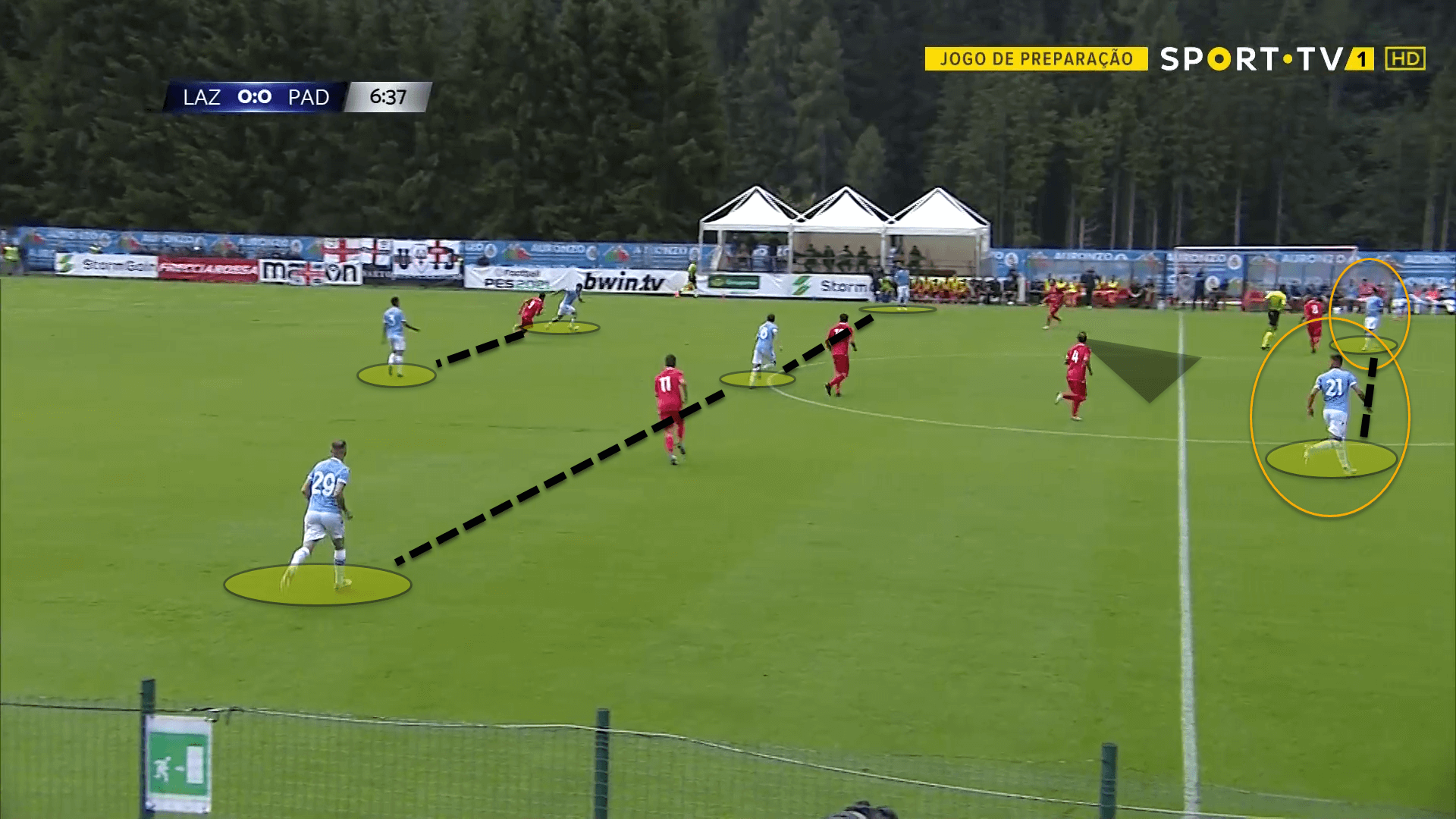
Here is an example of Alberto and Milinkovic-Savic positioning themselves in the halfspaces between the lines.
Both men have positional superiority in this area and if they are able to create a good angle for a pass, they have the quality to receive on the half-turn and drive forward, advancing Lazio further up the pitch – cutting through the opposition’s defensive medium-level block.
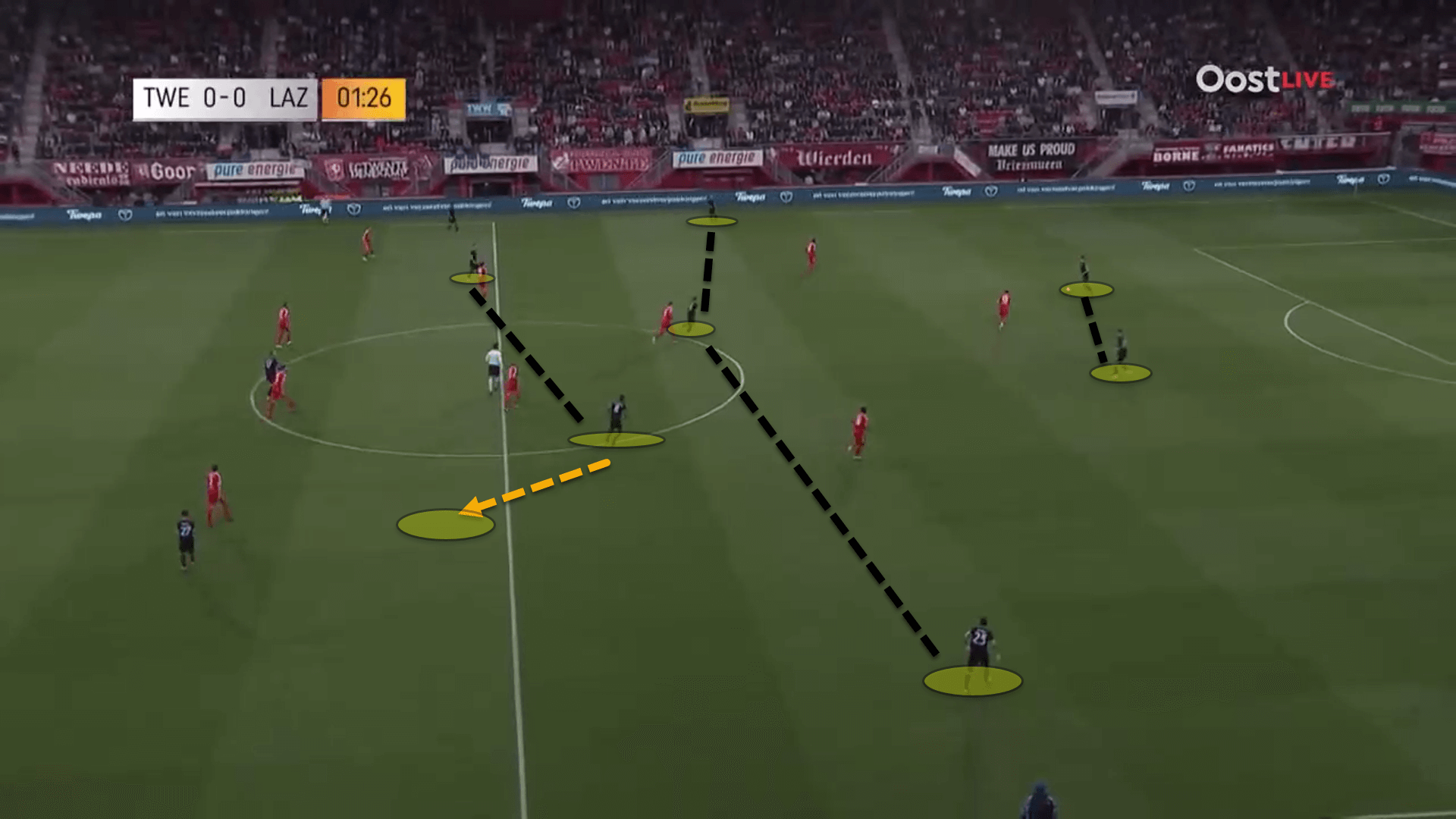
Again, a very similar structure can be seen here.
At times, the shape resembles a 2-3-2-3, although this is not a constant and can fluctuate depending on the game situation.
Lucas Leiva’s role will be very important and interesting to watch under Sarri.
The Italian manager tends to play single-pivots that possess excellent passing skills and an ability to dictate the tempo of the game such as Jorginho at Napoli and Chelsea and Miralem Pjanic at Juventus.
Leiva does not quite match the players listed as an archetypal Sarri ‘6’ but could potentially thrive under the Italian.
The former Liverpool midfielder will be tasked with dropping behind and in front of the opposition’s first line of pressure, taking the ball from the backline and circulating it around before trying to play line-breaking passes to more advanced players between the lines or out wide.
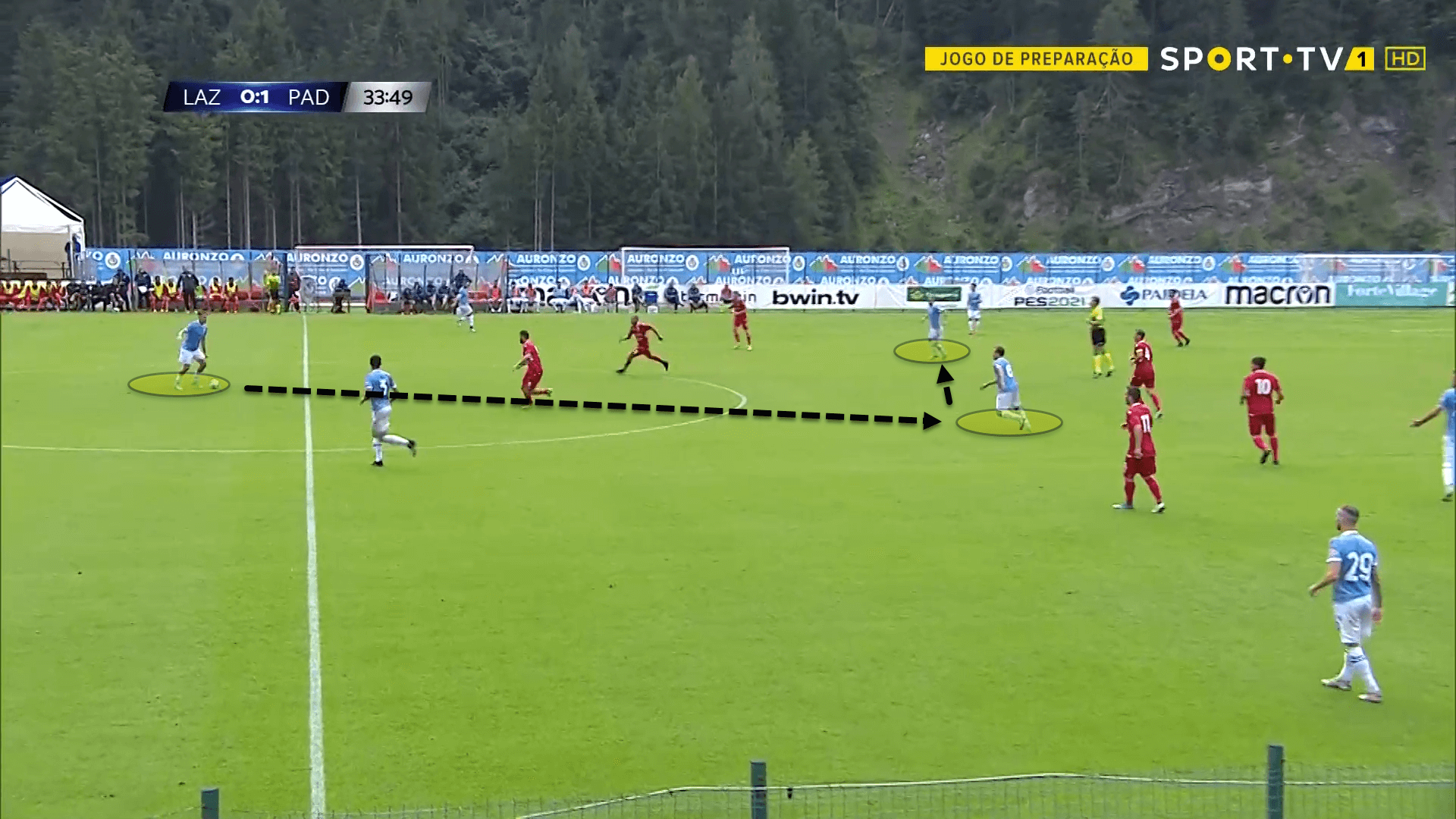
Reaching the final third
Sarri wants his sides to play through the opposition in the central areas, meaning Leiva will be extremely important for the Biancocelesti in facilitating this.
There are two main ways that Sarri wants his side to play through the opposition centrally.
Firstly, by using the up-back-through passing pattern.
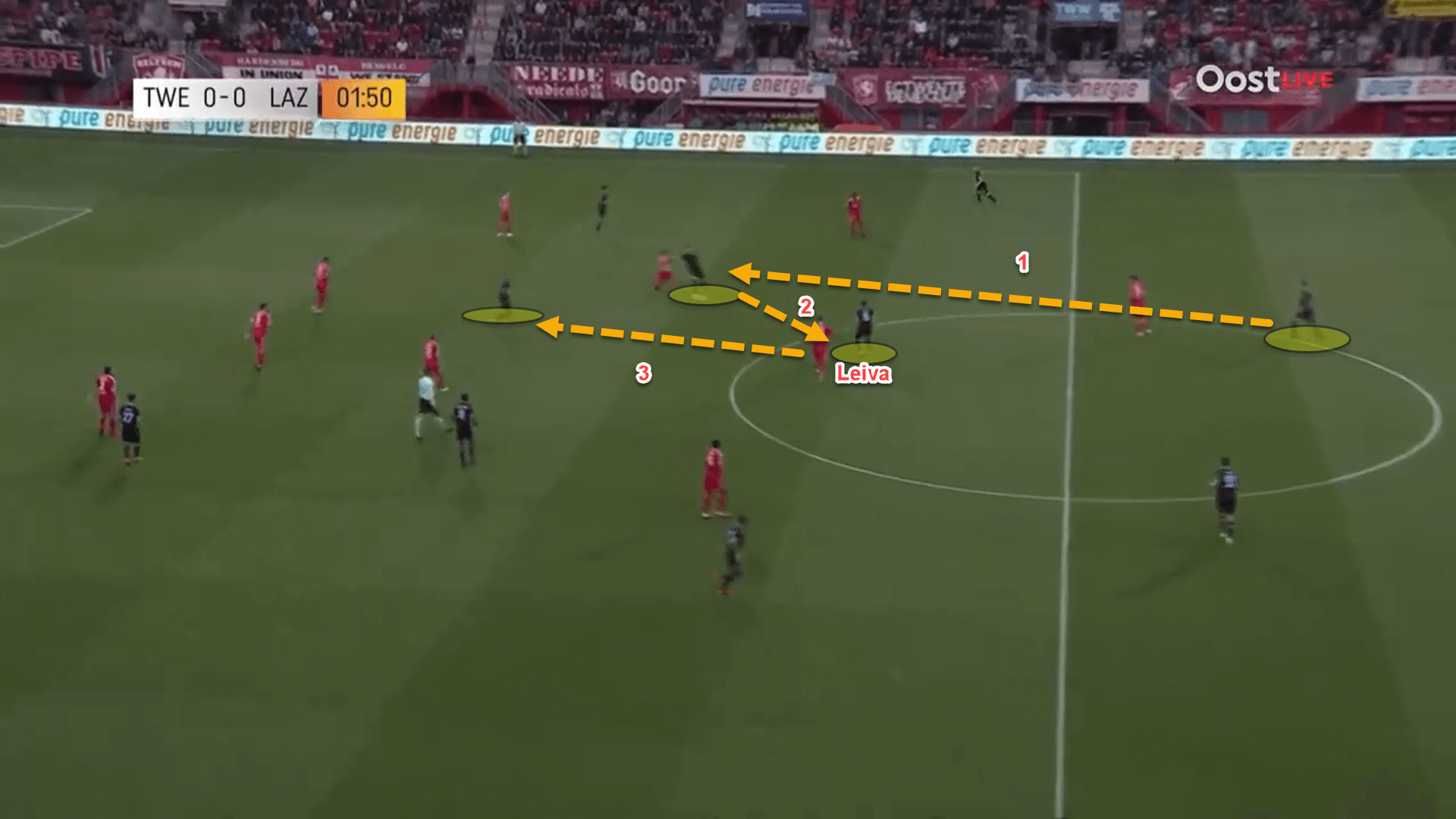
The up-back-through is used by most teams and can be a really efficient pattern of play when the team in possession has quality players to execute it.
In the example provided above, the right centre-back has played the ball into the feet of Milinkovic-Savic who acts as a wall pass and lays the ball off to Leiva.
The Brazilian then plays a first-time ball through the opposition’s lines and into Immobile who has dropped to receive – as Sarri wants his centre-forwards to do.
The Italian striker is now in a great position to turn and slip in a runner in behind the backline to create a goalscoring opportunity.
Again, having players with positional superiority between the lines is key for this to be utilised effectively and Lazio fans can expect to see quite a lot of this passing pattern under their new manager.
The second way that Sarri’s team breaks down an opponent centrally is by playing diagonal balls over the top to forwards who are attacking the depth.
Despite wanting his team to keep hold of possession and unlock the opposition’s defensive block using nice fluid passing, Sarri is no stranger to playing balls over the top of, or through, a backline.
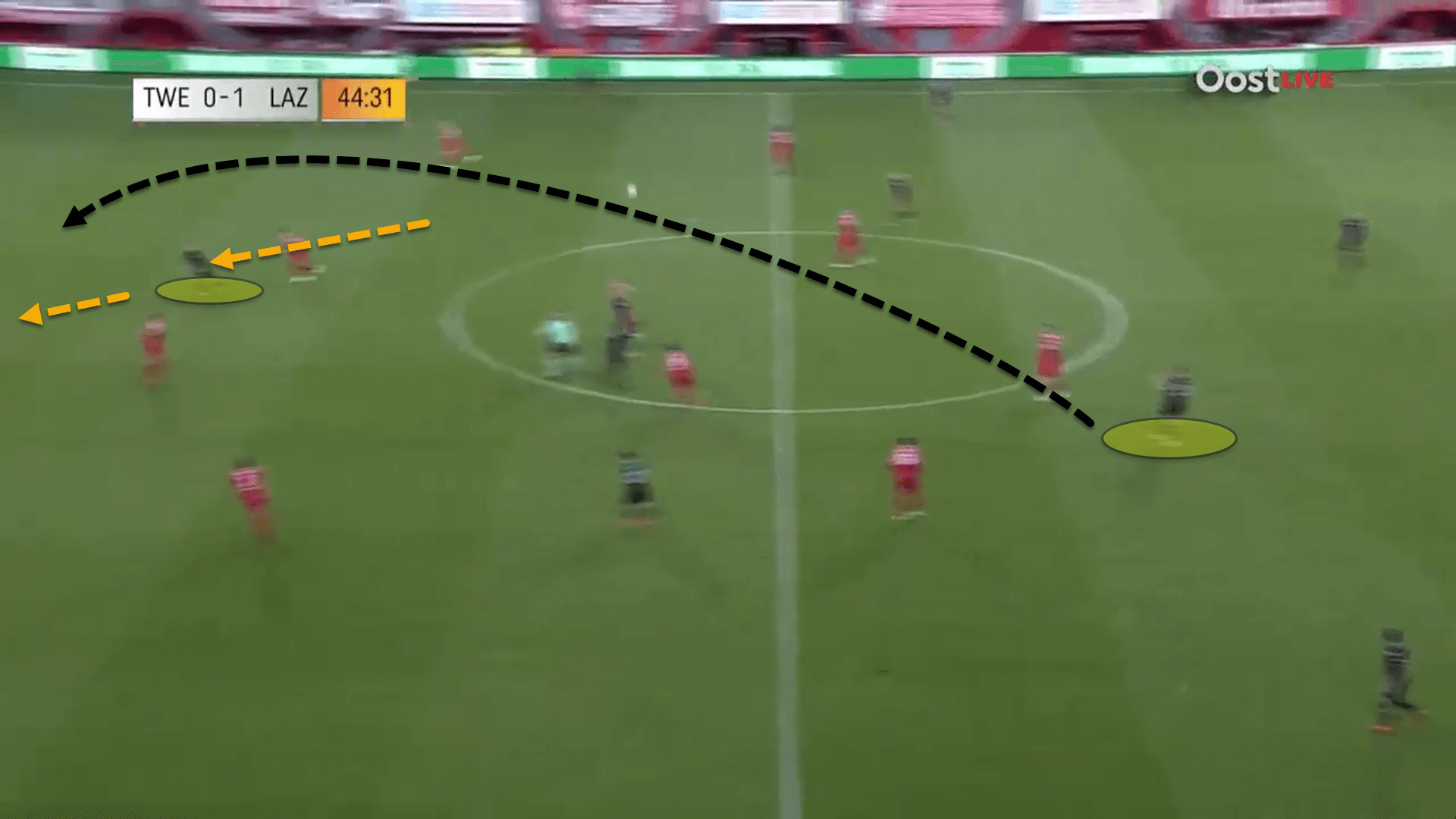
These diagonal runs are runs made by one of the front three which begin on the blindside of a defender.
Lorenzo Insigne at Napoli and Pedro at Chelsea were particularly good at making these runs under Sarri at their respective clubs.
Viewers will see Pedro do quite a lot of this again under Sarri in the coming season.
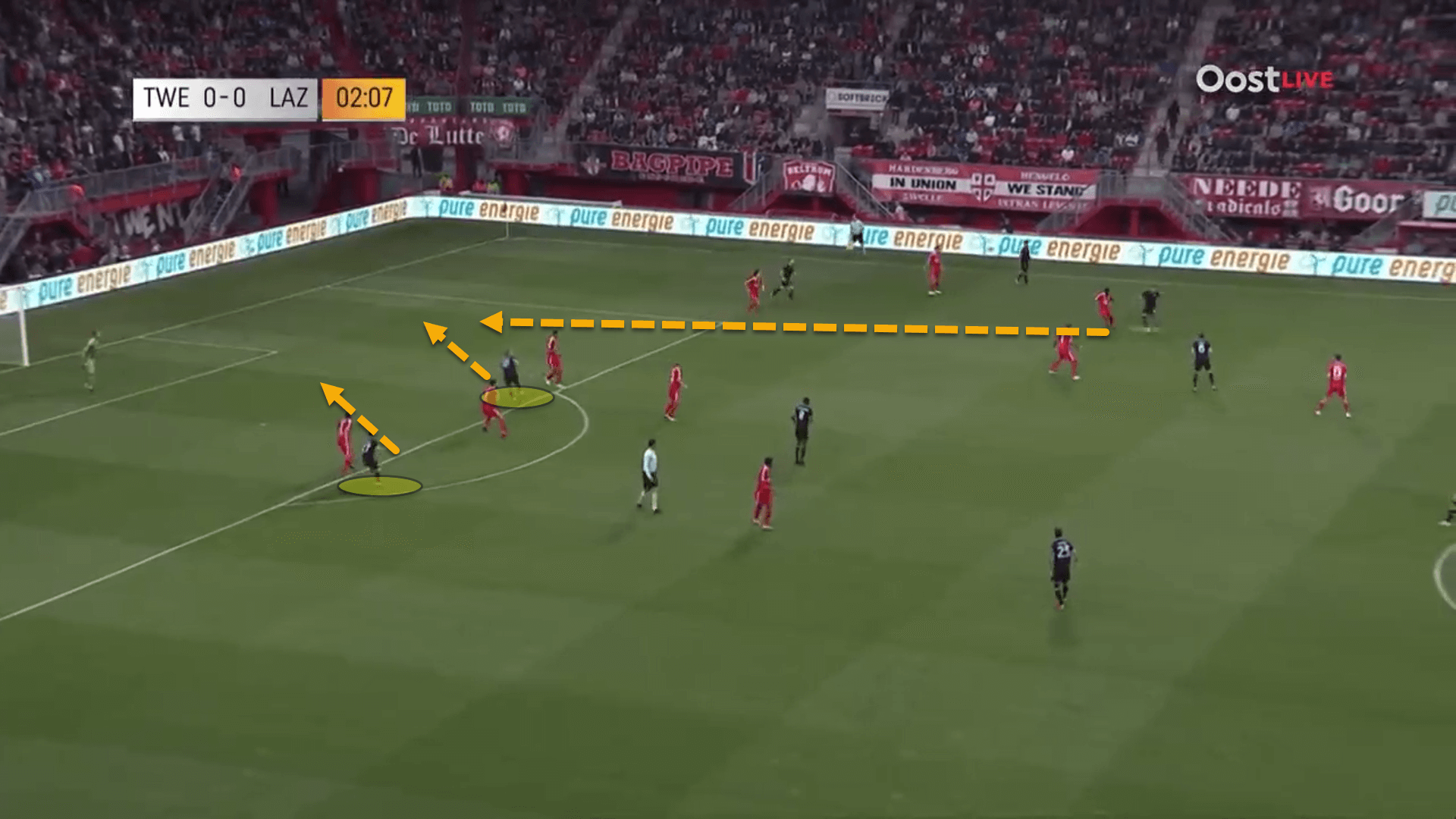
This example above led to a goal – Lazio’s only goal of the game against Twente in a 1-0 victory at De Grolsch Veste.
Immobile made yet another diagonal run on the defender’s blindside and was found with a wonderful line-breaking pass by Milinkovic-Savic.
Having forwards constantly attacking the depth as well as dropping deep to receive to feet is a key part of Sarri’s positional play style.
At times though, the central areas will be far too congested to play through, and if Lazio are failing to make any breakthroughs with diagonal balls in behind, they will need to try their luck down the flanks.
In situations like this, Sarri instructs his players to create wide overloads in order to try and break down their opponent out-wide with numerical superiority.
This is done by creating triangles or diamonds on the flanks.
The wide triangles are created by the winger, ball-near advanced midfielder, and fullback on the ball-side.
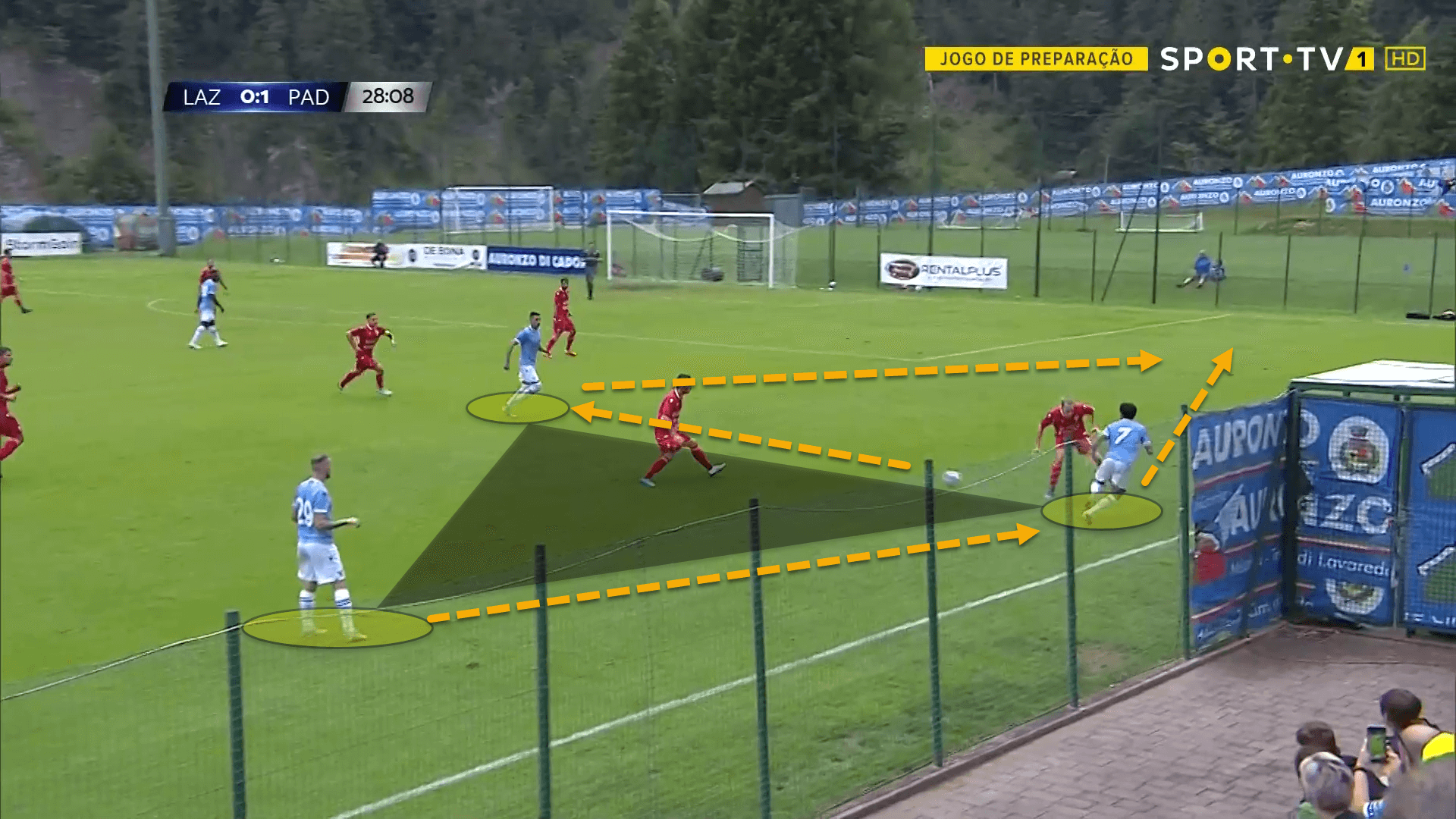
However, sometimes the single-pivot will shift across and add an extra body to aid them if the team are struggling to break through, which forms more of a diamond.
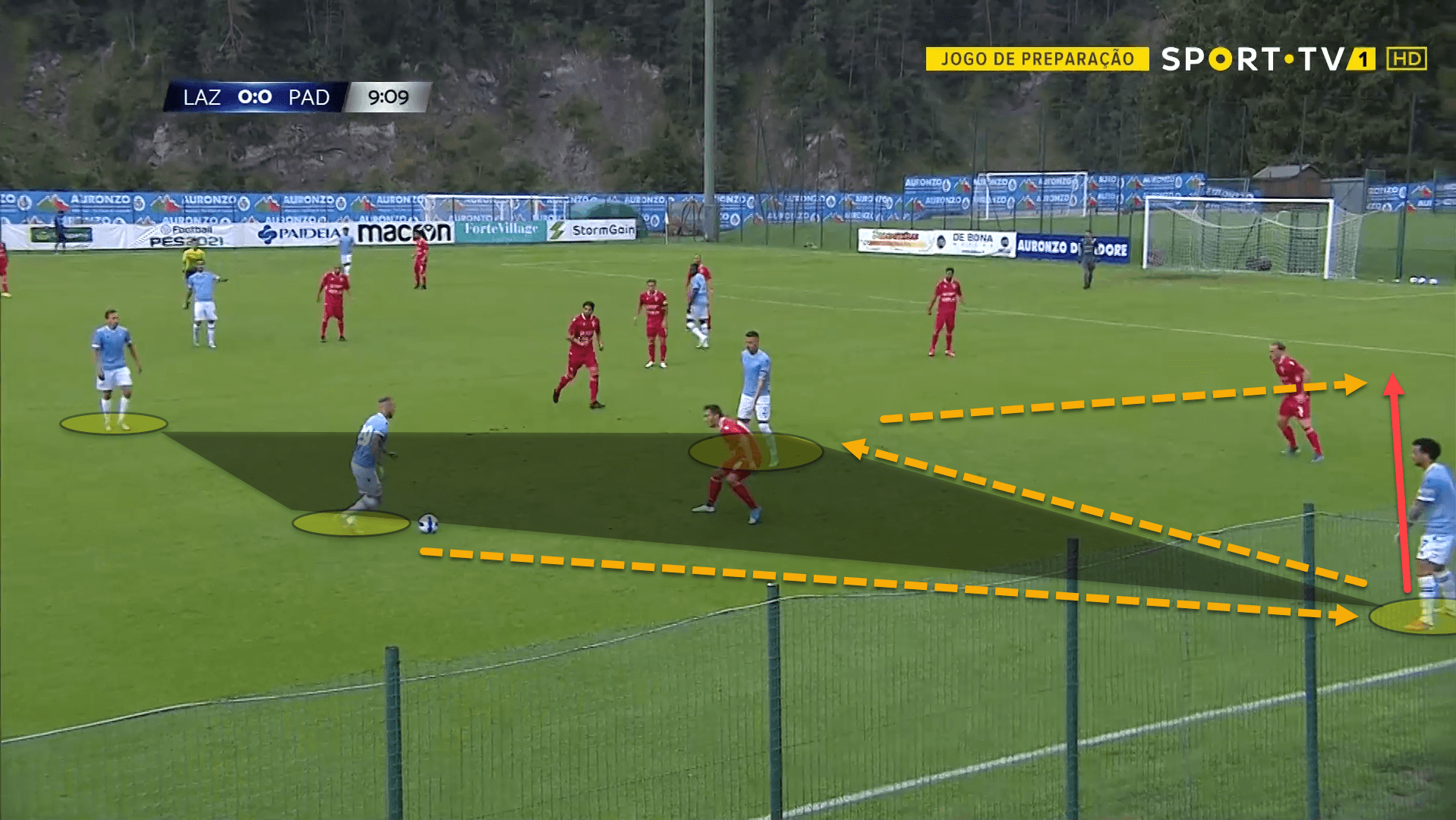
Conclusion
After watching two of Lazio’s pre-season games, the only two available on Wyscout, Maurizio Sarri still has his work cut out for him.
While the blueprint is clear to see, Lazio are still quite rough around the edges and only more minutes on the pitch and on the training ground will help them to get where Sarri wants them to be.
For instance, against Twente, Lazio averaged just 40 percent ball possession which is extremely low for a side trying to play a possession-oriented system.
Nonetheless, the Biancocelesti are shaping up to be one of the most entertaining sides to watch in Serie A this season, and with more games under his belt as the campaign progresses, Sarri should start seeing the system he wants formulating on the pitch.






Comments